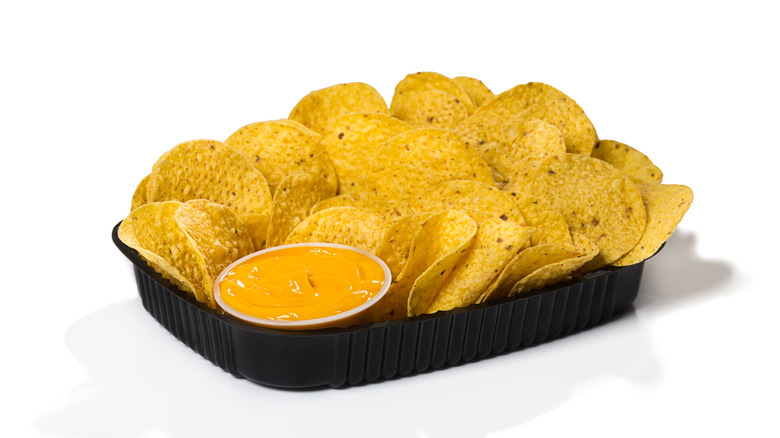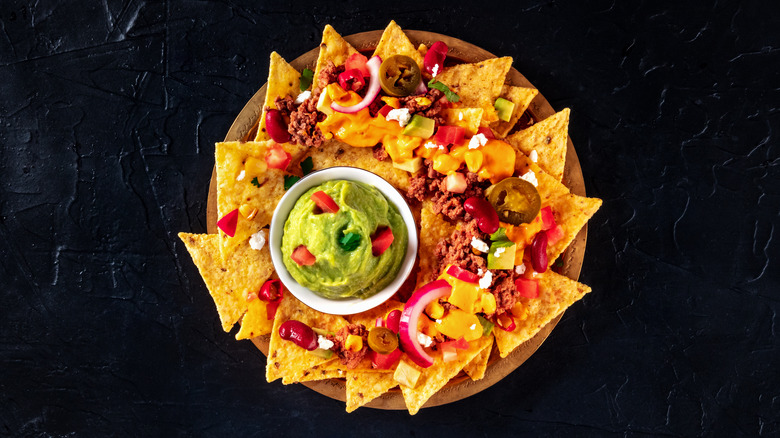The Genius Secret Message Behind The Formula For Nacho Cheese
Nacho cheese is a quintessentially modern American culinary concoction. It's smooth, creamy, tangy, and cheesy (of course), and is both loved and avoided in equal measure. When we say "nacho cheese," we don't just mean the cheese found on nachos in a sit-down Mexican restaurant. (That's usually a blend of authentic cheeses, generally with shredded and melted cheddar in the mix somewhere.) No, the nacho cheese discussed here is the fully liquid, brightly colored orange cheese sauce — more akin to queso or cheese soup, but thick and generally a little spicy to reflect a nod to Tex-Mex and/or Mexican cuisine. Nacho cheese is the stuff they use to cover tortilla chips sold at gas stations, convenience stores, baseball games, and at fast-food Mexican (or Tex-Mex) joints like Taco Bell.
True, and according to the FDA, nacho cheese is not technically, fully cheese — instead, it's designated as a cheese product made from cheese and a number of other ingredients, many of them chemicals, compounds, and preservatives. And the formula for how a lot of that nacho cheese is made contains a very clever joke, with some science behind it to back it up.
Nachos are from Mexico, nacho cheese is from Texas
According to The New York Times, nachos got their start in 1940, and owe their name to their creator. As the newspaper notes, Ignacio "Nacho" Anaya, who worked as a manager at the Victory Club, a restaurant in the Mexican border city of Piedras Negras, concocted the dish for hungry customers. Soon enough, nachos quickly grew in popularity around the U.S., and Frank Liberto, the owner of Ricos, a Mexican food supply company, wanted to create a variation that could be served quickly to customers who didn't want to wait for real cheese to melt.
To do so employs the use of sodium citrate, per the HuffPost. It's a kind of salt that also emulsifies, reducing the acid level in the cheese so as to make the proteins more soluble and ensuring that the mixture doesn't separate into its various components. In other words, it makes solid cheese into liquid cheese.
Amazingly and amusingly, the formula of sodium citrate, or the arrangement of the correct number of atoms of different chemicals to create it, hints toward its destiny as a transformative cheese additive. According to Byju's, sodium citrate consists of three parts sodium (Na), six parts carbon (C), five parts hydrogen (H), and seven parts oxygen (O). Put that all together and it forms the chemical formula Na3C6H5O7. Take out the numbers and it spells... N-A-C-H-O.
N-A-C-H-O spells delicious
According to Frank Liberto's son and Rico's successor, Tony Liberto, the basic nacho cheese sauce formulated and developed by the company comes condensed in a 107-ounce can, to which 32 ounces of water and 20 ounces of pepper juice are added to make for a smooth, spicy, pump-ready product, according to Smithsonian.
For those who are interested in trying their own hand at ooey, gooey goodness, products like Velveeta cheese have sodium citrate cooked right into them, per the ingredient list. That's why you see so many home queso renditions utilizing the orange-colored block, because of its N-A-C-H-O (sodium citrate) properties built in.
Whether you decide to opt for the original incarnation, or go with the fast and easy concession style, be sure to follow these tips to make your nachos mouthwatering. And if you're looking for the next best chip for some hot cheese, then here is some inspiration. Or if you're feeling especially daring, then try some nachos with tater tots instead of tortilla chips. Either way, it's bound to be delicious.


